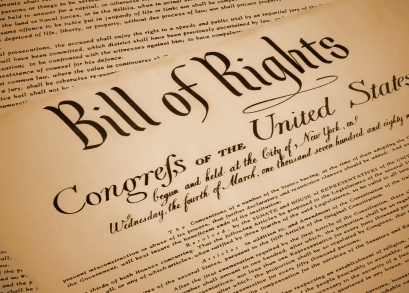Bill of Rights Lives On
Former N.Y. Times Vice President Talks First Amendment

To print or not to print? That’s the question. Whether ‘tis nobler in mind to take arms against a sea of troubles in the public interest, while in doing so inviting the slings and arrows of a powerful government?
The First Amendment prohibits the feds from interfering with the right of free speech or the press. Never. Well, as it turns out, hardly ever, if I may borrow a line from Gilbert and Sullivan while stealing from Shakespeare.
George Freeman, former vice president and assistant general counsel for The New York Times, told of a few instances in a talk Wednesday night marking Bill of Rights Day, sponsored by the Miller-McCune Center, SAGE Publications, and Antioch University. Exhibit A was the original newspaper printing of James Madison’s proposed first 10 amendments to the new-born U.S. Constitution, by the New-York Daily Gazette, on June 13, 1789.
That very page, acquired by SAGE’s Sara Miller McCune, was there, behind glass, full of “f”s instead of “s”s, and will be on display at the new SAGE Library at Antioch.
Everyone knows that the Times won in the Supreme Court (by a 6-3 vote) after it began publishing the Pentagon Papers, the classified account of how we got involved in Vietnam. Big deal at the time and drew the wrath of President Nixon, Freeman pointed out.
It took guts to publish, and Freeman said the Times’s business department was opposed, fearing such things as loss of advertising from adverse public reaction and that Nixon could retaliate by jerking the newspaper’s radio licenses. (The Bill of Rights doesn’t mention radio, TV, Internet, Twitter, or the like.)
On the other hand, a president can talk a newspaper out of printing a scoop, claiming that it would lead to bloodshed. Freeman recalled the Bay of Pigs disaster. President John Kennedy had just taken office in early 1961 and learned that the CIA, under President Eisenhower, was about to launch an attack on Fidel Castro’s Cuba. The Times learned of the plan and was about to publish a story. Didn’t the public have a right to know? Kennedy appealed to the Times to hold off, worried that it would lead to a disaster on the beach.
The Times did, but there was a disaster on the beach anyway, and Kennedy’s political nose was bloodied. Later, as Freeman told the group Wednesday night, Kennedy was famously quoted as saying he wished that the Times had printed the story so he would have had reason to cancel the operation.
As for the Bill of Rights, probed and dissected by the Supreme Court ever since being enacted as the first 10 Constitutional amendments, sometimes even mauled, it’s a wonder that it even exists. When the Founding Fathers signed off on the Constitution in 1789, they went home, awaiting ratification by the various states. But there was a rub. Objections were raised that individual rights weren’t sufficiently protected. Ratification was in jeopardy. So James Madison set to work on what he called a “nauseous project,” the brainteaser work of setting to print such things as protection against cruel and unusual punishment (still being debated; is the death penalty cruel?).
Not until December 15, 1791, when Virginia became the 11th state to ratify those 10 amendments, did the Bill of Rights become law. The Supreme Court has been interpreting and reinterpreting ever since. But it stands.


